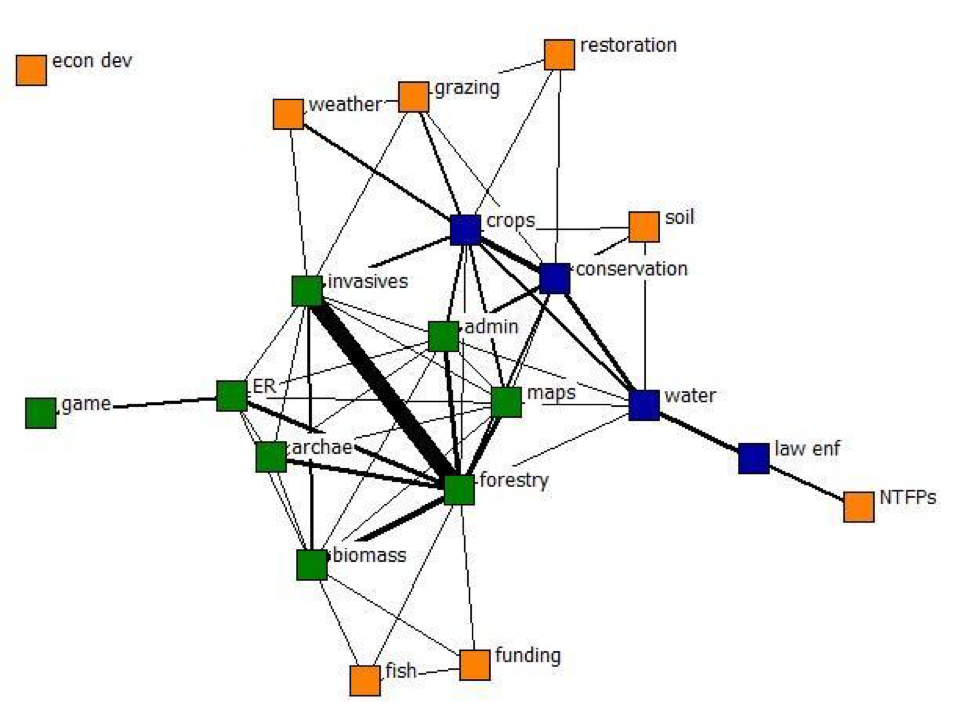
Hello, everyone! I’m Bethany Laursen, principal consultant at Laursen Evaluation & Design, LLC and doctoral student at Michigan State University. I love sense making tools, don’t you? I need help untangling complex data into meaningful findings! Social network analysis (SNA) is one of those tools, and it can do a lot more than its name indicates if you know how to hack it.
SNA is fundamentally network analysis, and you can study almost anything as a network. In fact, if you’re a systems thinker like I am, you probably do this already!
Hot Tip: All you need to hack SNA is at least one set of nodes and one set of edges. Stuck? A few inspiring questions include: What is flowing in my network? What do I care about? What is easy to measure?
Here are some basic examples:
| Nodes | Edges |
| Bus stops | Bus routes |
| Grants | Shared objectives |
| Land preserves | Wildlife migrations |
| Accounts | Fund transfers |
| Activities | Causes |
Level 2 hacking adds more edges to make a multiplex graph. For example, we might track shared personnel as well as shared objectives among grants. Level 3 hacks add another set of nodes to create 2-mode networks, such as bus stops with ATMs within one block. Combining levels 2 and 3 gets you to level 4—a multiplex, two-mode network (!). There are more secret levels to discover if you create new nodes and edges out of your original ones using the analytic transformations available in SNA software.
For example, I once turned a simple information-exchange network into a two-mode expert-expertise network, and then—through a co-affiliation transformation in UCINET—I ended up with an awesome group concept map of everyone’s shared expertise, where the nodes were expertise types and the edges were people recognized as those experts. How cool is that?

Lesson Learned: You can make intangible, complex constructs visible and interpretable by re-purposing SNA.
Lesson Learned: It’s fun to play with the possibilities of SNA, but in the end, you need to have a purpose for the information you generate. Having a good question to answer is half the secret of sense making tools.
Rad Resources: Here are some methods and tools that re-purpose SNA:
- Integrative propositional analysis: Coffee Break Webinar or Article
- Group concept mapping, e.g., Concept Systems
- Epistemic network analysis
- Discourse network analysis
- Mental Modeler
The American Evaluation Association is celebrating Social Network Analysis TIG Week with our colleagues in the Social Network Analysis Topical Interest Group. The contributions all this week to aea365 come from our SNA TIG members. Do you have questions, concerns, kudos, or content to extend this aea365 contribution? Please add them in the comments section for this post on the aea365 webpage so that we may enrich our community of practice. Would you like to submit an aea365 Tip? Please send a note of interest to aea365@eval.org. aea365 is sponsored by the American Evaluation Association and provides a Tip-a-Day by and for evaluators.

Thanks, Bethany, for two of the Rad Resources, which are about modeling dynamic networks. I have been searching for software that does this for some time, with an interest in developing dynamic Theories of Change. If you have experience using dynamic network models I would like to hear more.
Rick, glad you found useful resources. What do you mean by dynamic? Like, animated? Or snapshots over time? or something else?